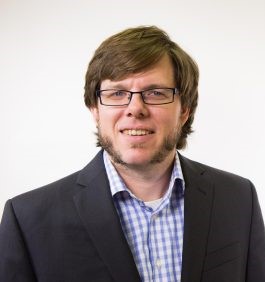Christopher Baker
Education
- University of Vermont, 2004, B.S.
- Dartmouth, 2010, Ph.D.
Research Interests
- Behavioral/Cognitive Sciences
- Bioinformatics/Computational Biology
- Development
- Genomics
- Molecular and Cellular Biology
- Stem Cells
Brief Biography
Genetics is the study of heredity and variation. The Baker Laboratory is ultimately interested in understanding how genetic variation manifests into phenotype. While all of us carry similar genetic code, we recognize and celebrate the fact that small differences provide the building blocks for the wealth of diversity we see among and between populations. It is also this genetic variation that can lead to differences in normal health, susceptibility or resilience to disease, and the origins of complex traits. Research over many years has identified that most of these genetic differences we carry in our DNA are not within genes, but rather in the regions of the genome which regulate how these genes are expressed. Furthermore, these regulatory regions are often transiently active during early development; and we operate under the hypothesis that genetic variation in regulatory activity during early development can have a big impact on adult phenotypes.
Between the genetic code in DNA and functional expression of genes there is a regulatory landscape of chromatin. Chromatin is the physical complex of proteins and DNA; however, chromatin is not static but rather is a dynamic substrate in which gene regulatory elements interact with a host of protein factors to fine tune cell-type specific genome function. Our primary focus is understanding how genetic variation impacts chromatin organization, downstream gene expression, and ultimately cell fate.
Much of genetic research in model organisms relies on a reductionist approach of studying one or a few mutant genes on otherwise isogenic backgrounds. Our goal is to use transformative genomic technologies to embrace genetic complexity and integrate systems genetics into meaningful biomedical research.
To access CV, please, press here.
Selected Publications
- Byers C, Spruce C, Fortin HJ, Hartig EI, Czechanski A, Munger SC, Reinholdt LG, Skelly DA, Baker CL. Genetic control of the pluripotency epigenome determines differentiation bias in mouse embryonic stem cells. EMBO J. 2022 Dec 17; 41(2):e109445
- Skelly DA, Czechanski A, Byers C, Aydin S, Spruce C, Olivier C, Choi K, Gatti DM, Raghupathy N, Keele GR, Stanton A, Vincent M, Dion S, Greenstein I, Pankratz M, Porter DK, Martin W, O’Connor C, Qin W, Harrill AH, Choi T, Churchill GA, Munger SC, Baker CL, Reinholdt LG. Mapping the Effects of Genetic Variation on Chromatin State and Gene Expression Reveals Loci That Control Ground State Pluripotency. Cell Stem Cell. 2020 Sep 3; 27(3):459-469.e8
- Ortmann D, Brown S, Czechanski A, Aydin S, Muraro D, Huang Y, Tomaz RA, Osnato A, Canu G, Wesley BT, Skelly DA, Stegle O, Choi T, Churchill GA, Baker CL, Rugg-Gunn PJ, Munger SC, Reinholdt LG, Vallier L. Naive Pluripotent Stem Cells Exhibit Phenotypic Variability that Is Driven by Genetic Variation. Cell Stem Cell. 2020 Sep 3; 27(3):470-481.e6
- Lau KX, Mason EA, Kie J, De Souza DP, Kloehn J, Tull D, McConville MJ, Keniry A, Beck T, Blewitt ME, Ritchie ME, Naik SH, Zalcenstein D, Korn O, Su S, Romero IG, Spruce C, Baker CL, McGarr TC, Wells CA, Pera MF. Unique properties of a subset of human pluripotent stem cells with high capacity for self-renewal. Nat Commun. 2020 May 15; 11(1):2420
- Spruce C, Dlamini S, Ananda G, Bronkema N, Tian H, Paigen K, Carter GW, Baker CL. HELLS and PRDM9 form a pioneer complex to open chromatin at meiotic recombination hot spots. Genes Dev. 2020 Mar 1; 34(5-6):398-412
- Mihola O, Pratto F, Brick K, Linhartova E, Kobets T, Flachs P, Baker CL, Sedlacek R, Paigen K, Petkov PM, Camerini-Otero RD, Trachtulec Z. Histone methyltransferase PRDM9 is not essential for meiosis in male mice. Genome Res. 2019 Jul; 29(7):1078-1086
- Baker CL, Walker M, Arat S, Ananda G, Petkova P, Powers NR, Tian H, Spruce C, Ji B, Rausch D, Choi K, Petkov PM, Carter GW, Paigen K. Tissue-Specific TransRegulation of the Mouse Epigenome. Genetics. 2019 Mar; 211(3):831-845
- Baker CL, Pera MF. Capturing Totipotent Stem Cells. Cell Stem Cell. 2018 Jan 4; 22(1):25-34
- Powers NR, Parvanov ED, Baker CL, Walker M, Petkov PM, Paigen K. The Meiotic Recombination Activator PRDM9 Trimethylates Both H3K36 and H3K4 at Recombination Hotspots In Vivo. PLoS Genet. 2016 Jun; 12(6):e1006146
- Narasimhan VM, Hunt KA, Mason D, Baker CL, Karczewski KJ, Barnes MR, Barnett AH, Bates C, Bellary S, Bockett NA, Giorda K, Griffiths CJ, Hemingway H, Jia Z, Kelly MA, Khawaja HA, Lek M, McCarthy S, McEachan R, O’Donnell-Luria A, Paigen K, Parisinos CA, Sheridan E, Southgate L, Tee L, Thomas M, Xue Y, Schnall-Levin M, Petkov PM, Tyler-Smith C, Maher ER, Trembath RC, MacArthur DG, Wright J, Durbin R, van Heel DA. Health and population effects of rare gene knockouts in adult humans with related parents. Science. 2016 Apr 22; 352(6284):474-7

